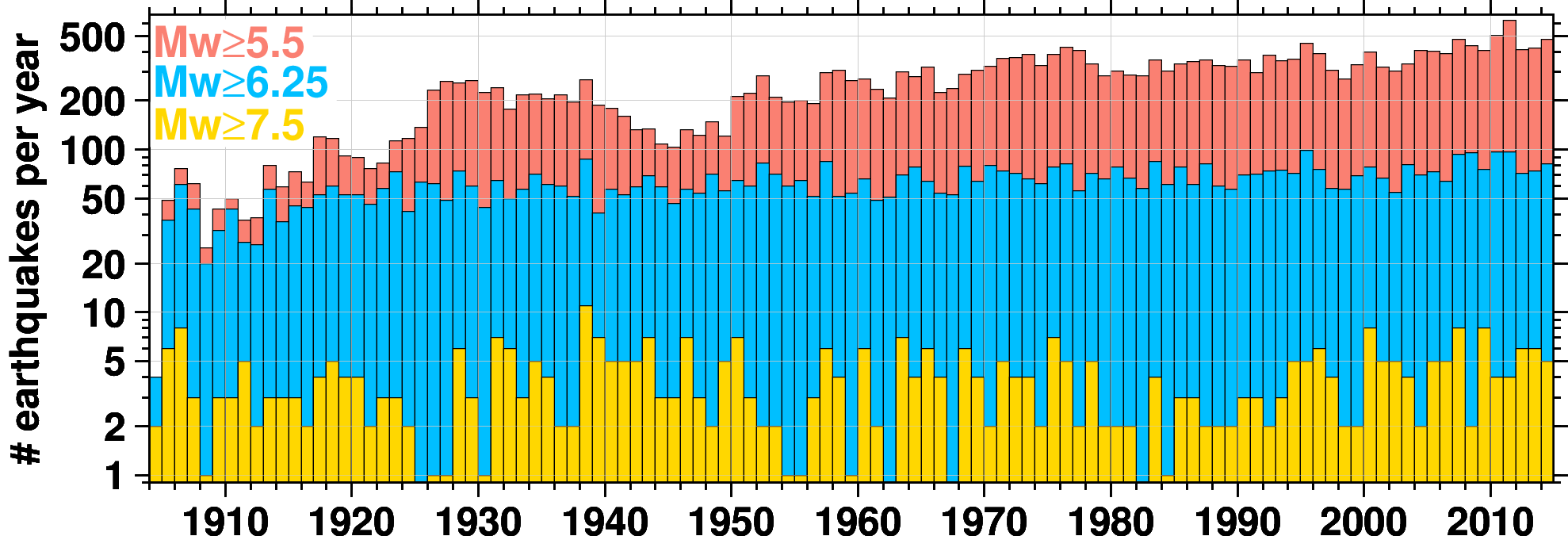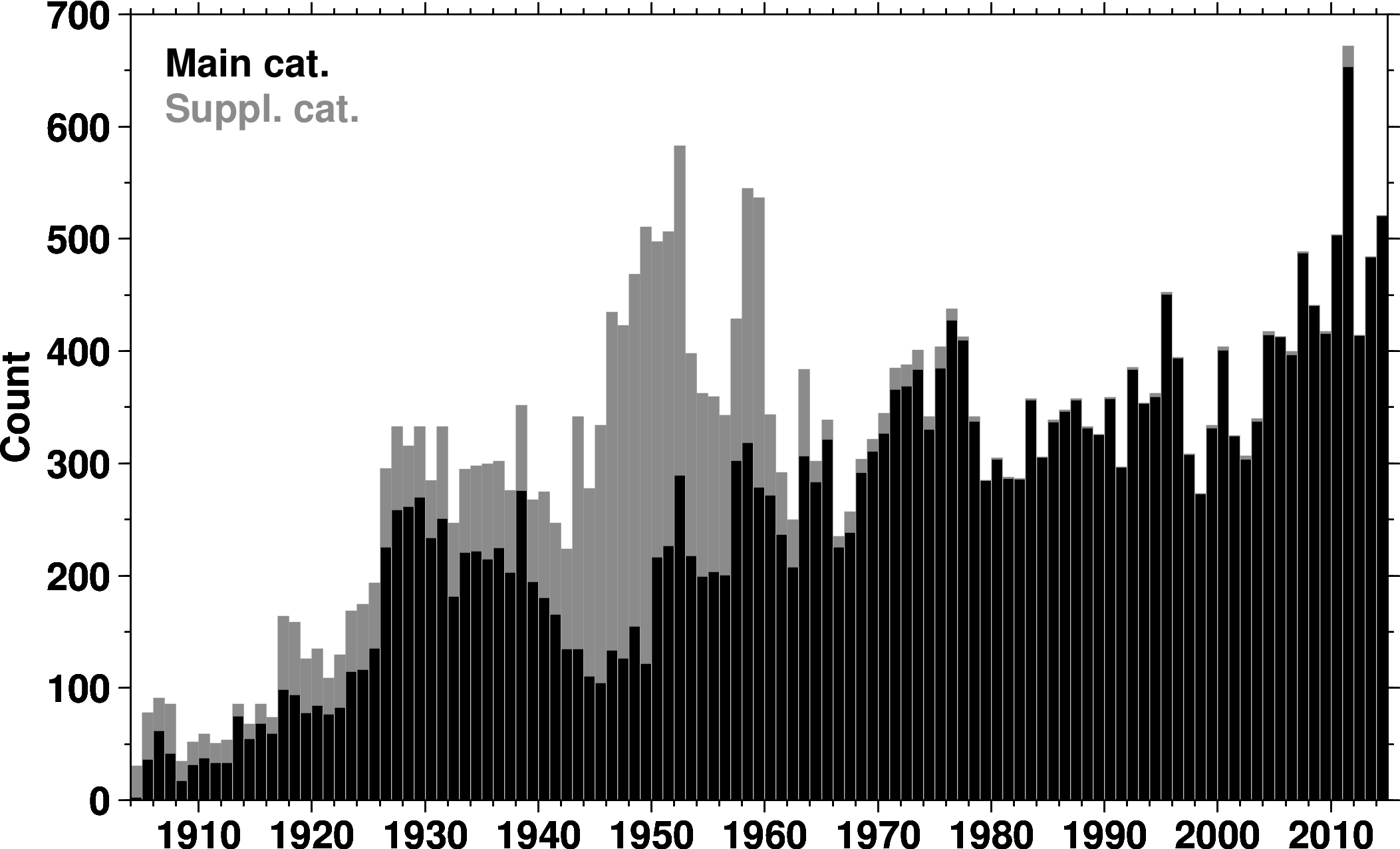Advancement of the ISC-GEM catalogue (Jan 2018 – Dec 2021)
At the end of 2017 we have finished the work on the Extension project that ended with public
release
of Version 5 of the ISC-GEM catalogue in February 2018. As a result of the Extension project, we
have considerably improved the magnitude cut-off thresholds during the early instrumental period
and
updated the catalogue with recent earthquakes during 2010-2014 (Fig. 1).

Whilst working on the last stages of the Extension project, we were planning further
investigations
and consequent catalogue improvements under the new Advancement project. This future work will
help
to maintain the comprehensive and homogeneous character of the ISC-GEM catalogue, add new data
to
both existing and new earthquakes and keep the catalogue up-to-date.
We plan the following work packages:
WP1: Investigate apparent station report gaps for surface wave data (1904-1970)
Over the last seven years we digitised and included the arrival time and body/surface wave
amplitude
and period information from a very large volume of individual station and network bulletins in
order
to re-compute the location and magnitude of each earthquake (Di Giacomo et al.,
2015a).
For each
earthquake, at least three different station reports were required to compute a reliable
estimate of
MS magnitude to be then converted to MW where the latter is not
independently available. The absence
of three consistent measurements has stopped many earthquakes from being included into the Main
ISC-GEM catalogue (Fig. 2). Such earthquakes remained part of the Supplementary catalogue of
earthquakes with highly uncertain determinations of magnitude and/or location.
Determination of the uniform MW magnitude throughout the ISC-GEM catalogue
is
based on either GCMT
or the MS/MW and mb/MW magnitude regression
curves developed during the project (Di Giacomo et al.,
2015b). However, the initial selection of earthquakes from the ISC Bulletin though was
not
based on
these regressions, as they were not available at the time.
We shall review the initial earthquake
selection during 1960-1990 and add a number of previously excluded moderate earthquakes in order
to
improve the magnitude completeness of the ISC-GEM catalogue during this period.
It would help regional studies of seismic hazard if we supplemented the ISC-GEM catalogue with
smaller yet still damaging earthquakes, such as the mb 5.2 Dulce, New Mexico 1966
earthquake (Fig.4)
or the MW 5.1 Lorca 2011 earthquake in Spain. This work would also assist
calibration of local
catalogues and magnitudes in individual regions where the ISC-GEM catalogue can be used as a
reference.
It is a common knowledge that recording of earthquakes at the beginning of the 20th
century was
often made by station networks with quite poor geometrical configuration with respect to the
earthquake sources. This resulted in low station azimuthal coverage and large uncertainties in
the
earthquake location. We would like to try working together with the macroseismic community to
review
parameters of large felt and damaging earthquakes during the 1900-1920 period where addition of
macroseismic information may lead to better-constrained hypocentre solutions.
At the time of major data entry work for the ISC-GEM catalogue, we have chosen to mainly use the
printed volumes of the International Seismological Summaries (ISS) and the ISC’s collection of
individual station and network bulletins because those contained well-formatted comprehensive
information in a tabulated form and have already been partly scanned and sometimes even
digitised.
Now we would like to complement these data with the data from Bureau Central
International
Seismologique (BCIS). For considerable periods of time, ISS in England and BCIS in
France
have been running global bulletin operations in parallel with an element of apparent duplication
in
their missions. The original sources of data coming to ISS and BCIS varied.
We shall concentrate on recovering additional station arrival times for earthquakes already in
ISC-GEM in order to improve the station azimuthal coverage and hence the accuracy of locations.
We
shall also look out for earthquakes that may have been missed by the ISS in those time periods
when
funding shortages dictated unfortunate rise in earthquake magnitude cut-off thresholds.
We plan to monitor recent publications (Fig. 5) in several tens of journals for new and updated
determinations of historical earthquake sources, magnitudes and moment tensor parameters based
on
analogue or digital seismogram records and update the ISC-GEM catalogue accordingly.
We shall make a concerted effort to link earthquakes in the ISC-GEM catalogue to known
bibliographical references to scientific articles describing these earthquakes.
We have already searched through scientific literature for accurate direct determination of
scalar
moment and moment magnitude of certain earthquakes studied by individual scientists or groups of
scientists. We have never attempted to include determinations of fault plane / moment tensor
solutions into the catalogue. These are usually derived by individual scientists from various
techniques and data sources such as digitized waveform inversions, visible surface rupture,
direction of body wave first motions, configuration of the aftershock zones etc (Fig. 6). It
would
be of considerable value for consequent seismic hazard studies, if the fault planes were also
included into the ISC-GEM catalogue, especially for the years before 1976 when the Global CMT
project has begun.
We are currently updating the ISC Bulletin (1964 onwards) with the recomputed ISC hypocentres
based
on the new location program, ak135 velocity model and robust magnitude calculation
scheme
(Bondár & Storchak, 2011). As part of this project, we bring numerous data of both
permanent and temporary (experimental and aftershock) deployments that were missing from the ISC
Bulletin.
We shall update the ISC-GEM catalogue in the modern instrumental period based on the previously
unavailable datasets that may help to improve the accuracy of ISC-GEM parameter determinations.
At the same time, together with University of Colorado Boulder, we are working on another
project to
review and improve the ISC-EHB dataset of well-recorded seismic events ordinarily used for
tomographic studies. This dataset benefits from more precise event depth determination. Some
earthquakes are common to both the ISC-GEM and the ISC-EHB.
We shall review the relevant outcomes from the ISC-EHB project to see which ISC-GEM earthquakes
may
require an update.
We shall continue the update of the ISC-GEM catalogue with earthquakes of recent years beyond
2014
as and when each new data year of the reviewed ISC Bulletin becomes available. We shall
implement
the same earthquake selection, location and magnitude determination procedure to keep the
ISC-GEM
catalogue as homogeneous as possible.
We shall incrementally improve the ISC-GEM catalogue. An upgraded version of the catalogue will
be made publicly available at the beginning of March of each following year, giving lead time to
Project Sponsors.
Bondar, I. and D. Storchak, 2011. Improved location procedures at the International
Seismological Centre, Geophys. J. Int., 186,
1220-1244, doi: 10.1111/j.1365-246X.2011.05107.x.
Di Giacomo, D., J. Harris, A. Villaseñor , D.A. Storchak, E.R. Engdahl, W.H.K. Lee and the Data
Entry Team, 2015. ISC-GEM: Global Instrumental Earthquake Catalogue (1900-2009), I. Data
collection
from early instrumental seismological bulletins, Phys. Earth Planet. Int., 239,
14-24,
doi: 10.1016/j.pepi.2014.06.003.
Di Giacomo, D., I. Bondár, D.A. Storchak, E.R. Engdahl, P. Bormann and J. Harris, 2015. ISC-GEM:
Global Instrumental Earthquake Catalogue (1900-2009): III. Re-computed MS and mb, proxy MW,
final
magnitude composition and completeness assessment, Phys. Earth Planet. Int., 239,
33-47, doi: 10.1016/j.pepi.2014.06.005.
Doser, D., 1990. Source characteristics of earthquakes along the Southern San Jacinto and
Imperial fault zones (1937 to 1954), Bull. Seism. Soc. Am., 80, 1099-1117.
Hoffman, J.P. and Northrop, S.A., 1977. The Dulce, New Mexico earthquake, January 23, 1966,
Seismol. Res. Lett., 49, 3-20.
Storchak, D.A., D. Di Giacomo, E.R. Engdahl, J. Harris, I. Bondár, W.H.K. Lee, P. Bormann and A.
Villaseñor, 2015. The ISC-GEM Global Instrumental Earthquake Catalogue (1900-2009):
Introduction,
Phys. Earth Planet. Int., 239, 48-63, doi:
10.1016/j.pepi.2014.06.009.

We believe that now is the right moment to review the report timelines of several tens of
individual
high-quality stations that have contributed surface wave amplitude and periods for the early
instrumental period before 1970. As an example, Figure 3 shows the timelines of amplitude and
period
reports from stations of the former USSR. Some of the distinct gaps observed in reporting of
many
stations can be explained by the devastation of the Second World War and consequent recovery and
re-establishment of many stations as part of the new united network of seismological
observations.
Nevertheless, it is worth investigating the apparent gaps and real availability of parametric
measurement data for those stations that were not in the temporarily occupied territories, such
as
BAK, IRK, MOS, SVE, TIF and VLA and for which the relevant data had been reported before the
war. We
would try contacting the individual stations to see if original operator’s reports or station
bulletins missing from the ISC collection are available there. We already have had reasonable
success making such enquiries in the past when suitable opportunities had risen during our
regular
ISC communication or travel.

We have to stress that certain advances are also expected in other areas/continents; the
stations of
former USSR have been chosen here only as an example. We believe that this work will help to
promote
many historical earthquakes from the Supplementary to the Main catalogue. Secondly, this work
will
bring additional data that will help to improve the accuracy of magnitude determinations (and
possibly the location) of those earthquakes already in the Main ISC-GEM catalogue.
WP2: Regularise the magnitude cut-off threshold (1960-1990)
WP3: Add earthquakes MW 5.0-5.5 in continental areas (1960-present)

We are planning to complement the ISC-GEM catalogue with earthquakes that occurred in
continental
areas since 1960, with MW between 5.0 and 5.5, based on the ISC Bulletin.
WP4: Use macroseismic information in support of instrumental data (1904-1920)
WP5: Bring additional station data from BCIS (1933-1968)
WP6: Integrate historical earthquake parameters from new and recent publications

WP7: Integrate earthquake fault plane solutions from scientific literature

WP8: Bring additional data from ISC Bulletin Rebuild project (1960-2010)
WP9: Integrate results of additional review under ISC-EHB project (1960-present)
WP10: Add earthquakes in recent years (2015-2018)
Deliverables
References

